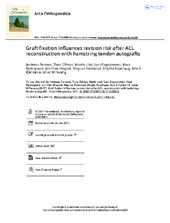Graft fixation influences revision risk after ACL reconstruction with hamstring tendon autografts : A study of 38,666 patients from the Scandinavian knee ligament registries 2004–2011
Persson, Andreas; Gifstad, Tone; Lind, Martin; Engebretsen, Lars; Fjeldsgaard, Knut; Drogset, Jon Olav; Forssblad, Magnus; Espehaug, Birgitte; Kjellsen, Asle; Fevang, Jonas Meling
Peer reviewed, Journal article
Published version

Åpne
Permanent lenke
https://hdl.handle.net/1956/17797Utgivelsesdato
2018Metadata
Vis full innførselSamlinger
Originalversjon
https://doi.org/10.1080/17453674.2017.1406243Sammendrag
Background and purpose — A large number of fi xation methods of hamstring tendon autograft (HT) are available for anterior cruciate ligament reconstruction (ACLR). Some studies report an association between fi xation method and the risk of revision ACLR. We compared the risk of revision of various femoral and tibial fi xation methods used for HT in Scandinavia 2004–2011. Materials and methods — A register-based study of 38,666 patients undergoing primary ACLRs with HT, with 1,042 revision ACLRs. The overall median follow-up time was 2.8 (0–8) years. Fixation devices used in a small number of patients were grouped according to design and the point of fi xation. Results — The most common fi xation methods were Endobutton (36%) and Rigidfi x (31%) in the femur; and interference screw (48%) and Intrafi x (34%) in the tibia. In a multivariable Cox regression model, the transfemoral fi xations Rigidfi x and Transfi x had a lower risk of revision (HR 0.7 [95% CI 0.6–0.8] and 0.7 [CI 0.6–0.9] respectively) compared with Endobutton. In the tibia the retro interference screw had a higher risk of revision (HR 1.9 [CI 1.3–2.9]) compared with an interference screw. Interpretation — The choice of graft fi xation infl uences the risk of revision after primary ACLR with hamstring tendon autograft.
